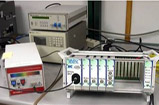|
Journal: ISRN Spectroscopy
Paper: Laser Induced Breakdown Spectroscopy; fundamentals, applications and challenges
AUTHORS: F. Anabitarte, A. Cobo, J.M. López-Higuera
Abstract: Laser-induced breakdown spectroscopy (LIBS) is a technique that provides an accurate in situ quantitative chemical analysis, and, thanks to the developments in new spectral processing algorithms in the last decade, has achieved a promising performance as a quantitative chemical analyzer at the atomic level. These possibilities along with the fact that little or no sample preparation is necessary have expanded the application fields of LIBS. In this paper, we review the state of the art of this technique, its fundamentals, algorithms for quantitative analysis or sample classification, future challenges and new application fields where LIBS can solve real problems.
|
|
Journal: Óptica Pura y Aplicada
Paper: Espectroscopia Óptica de imagen para el control de calidad en la industria alimentaria, monitorización en línea de procesos de soldadura y discriminación de patologías tumorales en tejidos cancerígenos
AUTHORS: P. Beatriz García-Allende, Olga M. Conde Portilla
Abstract: La espectroscopia óptica se ha empleado en múltiples campos, ya sea bio‐)químicos, biológicos, físicos o astronómicos debido a su gran especificidad, ya que cada sustancia es distinguible de forma inequívoca de todas las demás a partir de sus propiedades espectrales. El análisis de un material no homogéneo requeriría o bien enfocar sucesivamente el sistema óptico punto a punto sobre la superficie del mismo, replicar los sistemas de iluminación y captación o realizar una única medida promedio tal y como hace la espectroscopia clásica. Una forma mucho más eficiente de abordar el análisis y posterior establecimiento de la distribución local de las propiedades de materiales no homogéneos es mediante la técnica denominada espectroscopia de imagen, que consiste en la medida simultánea de las componentes ópticas del espectro y la localización espacial del mismo. Debido a sus características de operación mínimamente invasivas esta técnica puede dar solución a multitud de problemas en diversos sectores industriales y en la diagnosis médica. Este trabajo revisa un compendio de soluciones basadas en espectroscopia de imagen hiperespectral para diversas problemáticas existentes en los sectores agroalimentario, industrial y de diagnosis médica. Dichas contribuciones se realizaron dentro del marco de la tesis doctoral de Pilar Beatriz Garcia Allende titulada “Contribuciones al desarrollo de nuevas técnicas de interpretación y sistemas basadas en espectroscopia de imagen”. Inicialmente se describe el diseño y montaje de un sistema de imagen hiperspectral así como su validación para la discriminación en línea de producción de materias primas. A continuación se describe la extensión de su aplicación a la monitorización en tiempo real de procesos de soldadura y finalmente, se analizarán las modificaciones necesarias en el sistema de adquisición para extraer información relevante de tejidos biológicos que permitan determinar el margen quirúrgico en cirugías de resecación de cáncer. Adicionalmente se presentará un método automático de interpretación de la firma espectral de esparcimiento que permite no solamente determinar el margen tumoral sino también la distinción de diversas patologías asociadas a éste
|
|
Journal: Optics Express
Paper: Sample Fiber Bragg Grating Spectral synthesis
AUTHORS: L. Rodriguez-Cobo, A. Cobo, J.M. López-Higuera
Abstract:In this paper, a technique to estimate the deformation profile of a Sampled Fiber Bragg Grating (SFBG) is proposed and experimentally verified. From the SFBG intensity reflection spectrum, any arbitrary longitudinal axis deformation profile applied to a SFBG is estimated. The synthesis algorithm combines a custom defined error metric to compare the measured and the synthetic spectra and the Particle Swarm Optimization technique to get the deformation profile. Using controlled deformation profiles, the proposed method has been successfully checked by means of simulated and experimental tests. The results obtained under different controlled cases show a remarkable repetitiveness (< 50 με) and good spatial accuracy (< 1 mm).
|
|
Journal: IEEE Sensors Journal
Paper: Raw Material Classification by means of Hyperspectral Imaging and Hierarchical Temporal Memories
AUTHORS: Luis Rodriguez-Cobo, P. Beatriz García-Allende, Adolfo Cobo, José M. López-Higuera, Olga M. Conde
Abstract: The recently proposed hierarchical temporal memory HTM) paradigm of soft computing is applied to the detection and classification of foreign materials in a conveyor belt carrying tobacco leaves in a cigarette manufacturing industry. The HTM has been exposed to hyperspectral imaging data from 10 types of unwanted materials intermingled with tobacco leaves. The impact of the HTM architecture and the configuration of internal parameters on its classification performance have been explored. Classification results match or surpass those attained with other methods, such as Artificial Neural Networks (ANNs), with the advantage that HTM are able to handle raw spectral data and no preprocessing, spectral compression, or reflectance correction is required. It is also demonstrated that an optimized configuration of the HTM architecture and internal values can be derived from the statistical properties of the hyperspectral data, allowing the
extension of the approach to other classification problems.
|
|
<< Inicio < Anterior 11 12 13 14 15 16 17 18 19 20 Siguiente > Final >>
|
| Resultados 45 - 48 de 117 |
 Noticias
Noticias 





